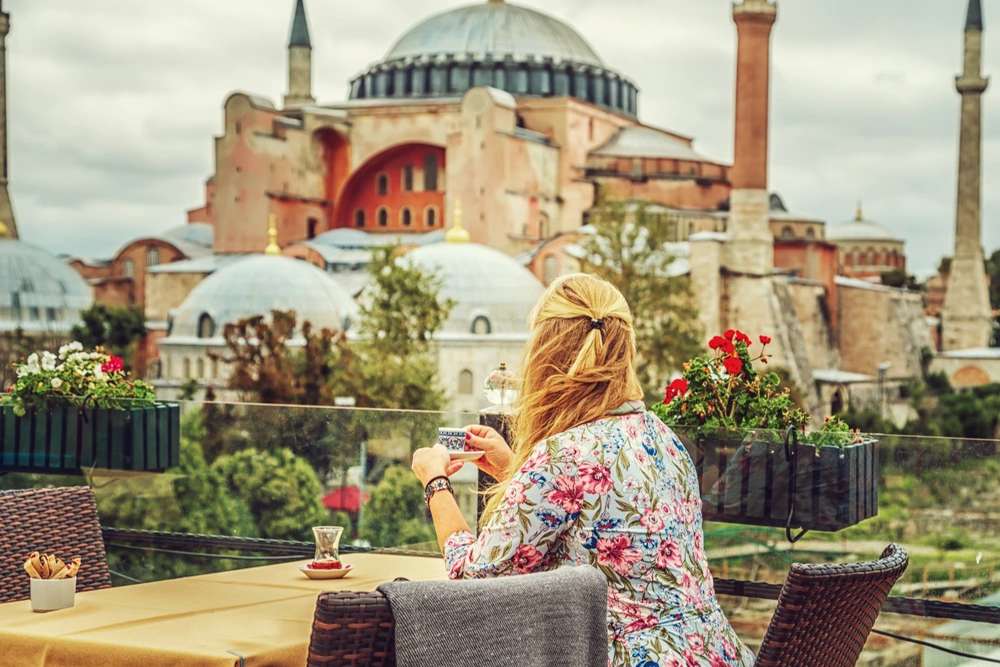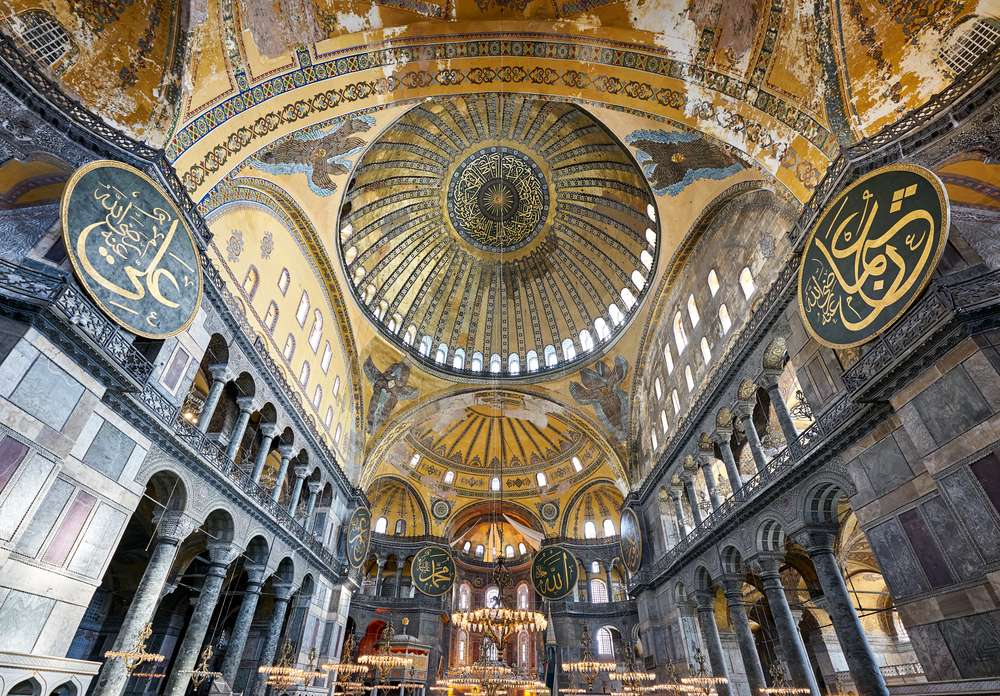
The Majestic Wonder of Hagia Sophia
In the heart of Istanbul's historic center stands a magnificent architectural marvel, the Hagia Sophia. This sacred building, officially known as the Ayasofya-i Kebir Cami-i Şerifi or the Hagia Sophia Grand Mosque, is a symbol of power and a testament to the rich history of the Byzantine Empire. Commissioned by Emperor Justinian and consecrated as the Hagia Sophia in 537, it has undergone various transformations over the centuries, reflecting the changing religious and political landscape of Istanbul.
What does Hagia sophia Mean

According to the origin of the building's name, it is incorrect to assume that it was named after a saint called Sophia. In reality, the church was dedicated to Theia Sophia, representing the concept of Holy Wisdom within the Christian trinity. The term "Hagia Sophia," which it was later named, combines the words Aya (meaning holy or saint) and Sophos (meaning wisdom), conveying the idea of divine wisdom.
The Origins: A Church of Divine Wisdom
The story of the Hagia Sophia begins in the 6th century when Emperor Justinian I envisioned a grand church that would surpass any other in size and magnificence. The construction of the Hagia Sophia was a remarkable feat, as it was the first building to feature a pendentive dome on such a large scale. Architects Isidore of Miletus and Anthemius of Tralles were entrusted with bringing Justinian's vision to life.
The original church, consecrated as the Hagia Sophia or the Church of Divine Wisdom, was an awe-inspiring structure. Its size was unparalleled and would remain unmatched for nearly a millennium. The sheer audacity of Justinian's vision is evident in the daring engineering feats and meticulous craftsmanship that went into its construction.
The Byzantine Era: A Symbol of Byzantium
During the Byzantine era, the Hagia Sophia served as the focal point of the Greek Orthodox faith. It was the Cathedral of the Ecumenical Patriarchate of Constantinople, the spiritual and political center of the Byzantine Empire. The church played a pivotal role in the religious and cultural life of Constantinople, with new emperors being crowned within its walls.
The interior of the Hagia Sophia was adorned with Byzantine finery, showcasing intricate mosaics and frescoes. The narthex, or entrance hall, featured bronze doors and stunning mosaics depicting Emperor Justinian, Emperor Constantine, and the Virgin Mary with the Christ child. The inner narthex housed the Imperial Door, reserved exclusively for the Byzantine emperor's procession.
The Ottoman Era: Conversion to a Mosque
In 1453, the Ottoman Empire, led by Sultan Mehmet II, conquered Constantinople, marking the end of the Byzantine Empire. The Hagia Sophia was converted into a mosque, and significant changes were made to accommodate Islamic worship. Minarets were added to the exterior, and the interior was adorned with Islamic calligraphy and decorative elements.
The prayer hall, once the grand nave of the church, became a fusion of Christian and Islamic design. Delicate mosaics and marble-paneled walls were complemented by chandeliers, medallions inscribed with Islamic texts, and geometric patterns adorning the semi-domes and arches. The Hagia Sophia became a symbol of Ottoman grandeur, reflecting the cultural synthesis between Christianity and Islam.
From Museum to Mosque: Modern Transformations
In 1935, under the secularist government of Kemal Atatürk, the Turkish government declared the Hagia Sophia a museum. This decision aimed to preserve its historical and cultural significance as a symbol of both Byzantine and Ottoman heritage. The museum status allowed visitors from around the world to appreciate the architectural and artistic treasures within its walls.
However, in 2020, the Hagia Sophia underwent another transformation. The Turkish government, under the leadership of President Recep Tayyip Erdoğan, decided to reconvert the Hagia Sophia into a working mosque. This decision sparked debates and controversy, as it signaled a shift in Turkey's secularist stance. Islamic prayers resumed in the Hagia Sophia, and certain sections of the building were cordoned off for worshippers.
Exploring the Hagia Sophia: A Journey Through Architecture
The Exterior: A Testament to Engineering Brilliance
The Hagia Sophia's exterior is a sight to behold, with its massive dome seemingly suspended from heaven. The architectural marvel of the dome is a testament to the ingenuity of Isidore of Miletus and Anthemius of Tralles. The dome stands 56 meters high and spans 33 meters in diameter, supported by pendentives that distribute its weight to the corners of the building.
The minarets, added during the mosque conversion, punctuate the skyline and provide a distinct Islamic character to the Hagia Sophia. The exterior walls, clad in marble, bear witness to centuries of history, from the Byzantine period to the Ottoman era.
The Interior: A Splendor of Byzantine and Islamic Artistry
Stepping inside the Hagia Sophia, visitors are greeted by a breathtaking display of Byzantine and Islamic artistry. The prayer hall, once the nave of the church, is a symphony of colors, textures, and architectural elements.
The chandeliers hanging from the soaring ceiling cast a warm glow, illuminating the medallions inscribed with the names of God, the Prophet Muhammad, and the first caliphs. Geometric designs adorn the yellow-plastered semi-domes, domes, and arches, creating a mesmerizing visual spectacle.
Visitors can witness the Weeping Column, believed to have been blessed by St. Gregory the Miracle Worker. The pillar, worn by centuries of believers seeking miracles and cures, stands as a testament to the enduring faith associated with the Hagia Sophia.
The Omphalion: Where Emperors Were Crowned
A highlight of the Hagia Sophia is the omphalion, a square section of inlaid stone located in the southeast of the prayer hall. This unique design, consisting of 30 circles made from red and green porphyry, granite, and verd antique, marks the spot where new emperors were crowned during the Byzantine era.
Surrounded by the teal-colored carpet that now covers the marble floor, the omphalion serves as a potent reminder of the Byzantine Empire's grandeur and the historical significance of the Hagia Sophia.
The Dome's Seraphim: Guardians of the City
The pendentives supporting the dome are adorned with seraphim, celestial beings depicted in mosaics and frescoes. Two original mosaics and two frescoes from the 1847 restoration grace the pendentives, adding a touch of mysticism to the Hagia Sophia. According to local legend, these seraphim protect the city from disaster, their watchful presence serving as a source of comfort and awe.
The Upper Gallery: Unveiling Byzantine Treasures
While the upper gallery of the Hagia Sophia is currently closed for restoration, it is worth mentioning the famous mosaics that once adorned its walls. The Emperor Constantine IX and Empress Zoe Mosaic, as well as the Emperor John Komnenos II and Irene Mosaic, showcased the Byzantine Empire's opulence and artistic prowess. These masterpieces captured the essence of Byzantine society and its rulers, providing glimpses into a bygone era.
Conclusion: A Living Testament to History and Faith
The Hagia Sophia stands as a living testament to the rich history, architectural brilliance, and cultural synthesis of Istanbul. From its humble beginnings as a church to its transformation into a mosque and museum, it has witnessed the rise and fall of empires, the clash of civilizations, and the enduring power of faith.
Today, as a working mosque, the Hagia Sophia continues to inspire awe and captivate visitors from around the world. Its grandeur, intricate mosaics, and soaring dome serve as reminders of the ingenuity and artistic achievements of humanity.
Whether you visit to marvel at its architectural wonders, appreciate its historical significance, or seek solace in its sacred atmosphere, the Hagia Sophia is an enduring symbol of Istanbul's vibrant past and cultural legacy.
Check out the Best Turkey Tours NOW!
Related Tours








































